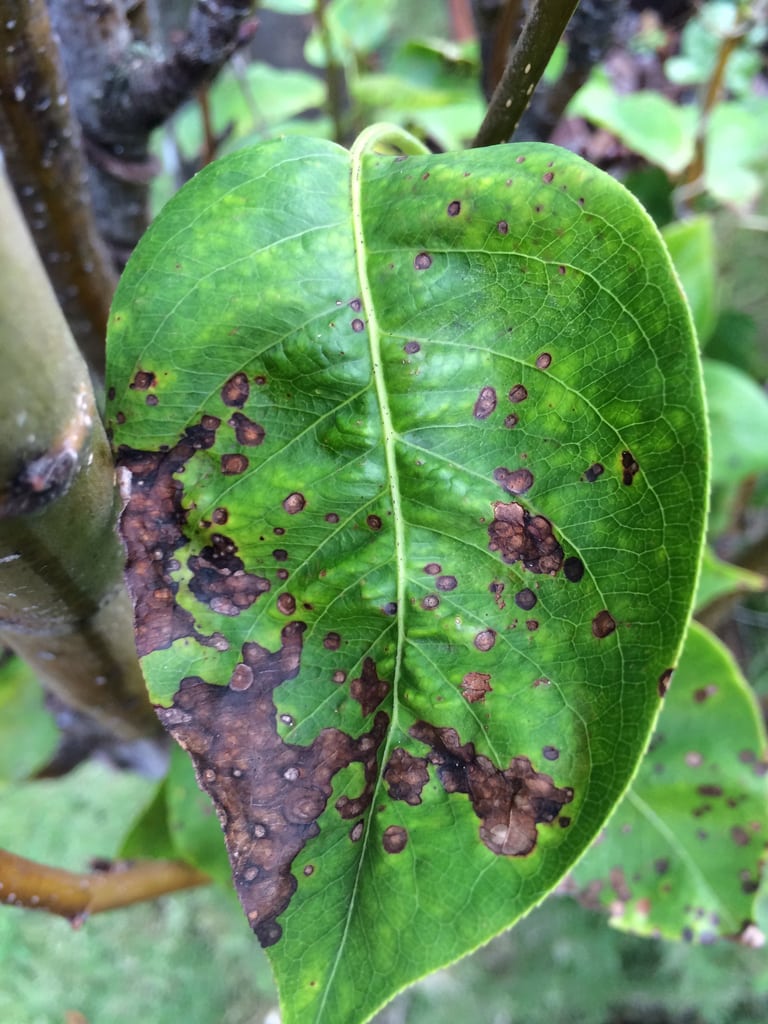Pear Fruit Spot Info: What Causes Pear Leaf Blight


Pear leaf blight and fruit spot is a nasty fungal disease that spreads quickly and can defoliate trees in a matter of weeks. Although the disease is difficult to eliminate, it can be successfully managed by using a combination of approaches. Let’s learn how to treat pear fruit spot.
What Causes Pear Leaf Blight?
Pear leaf blight and fruit spot is caused by Fabraea maculata, a fungus that infects all parts of the tree. The bacteria are carried to other trees by insects, wind, splashing water, and rain.
Pear Fruit Spot Info
Symptoms of pear leaf blight and fruit spot are fairly easy to discern. Fruit spots appear as small, purplish spots, generally on the younger, lower leaves. As the lesions mature, they become purplish black or brown with a small pimple in the center. A yellow halo may develop around the lesions. When the foliage is wet, a gooey, shiny mass of spores oozes from the pimple. Eventually, severely infected foliage turns yellow and leaves drop from the tree. Purple to black lesions, with spores, also appear on twigs. Lesions on pears are slightly sunken and black.
How to Treat Pear Fruit Spot
Treating pear fruit spot requires a combination of chemical and cultural practices. Apply fungicides as soon as leaves are fully developed, then repeat three more times at two-week intervals. Spray the tree thoroughly until the fungicide drips from the leaves. Water pear trees carefully and keep the foliage as dry as possible. Use a drip system or allow a hose to drop slowly at the base of the tree. Avoid overhead irrigation. Ensure adequate spacing between trees to increase air circulation, and to allow sunlight to penetrate the foliage. Rake and burn fallen plant debris in fall. Pathogens overwinter on older leaves. Prune infected growth to healthy wood as soon as it appears. Remove dead branches and twigs, as well as damaged fruit. Disinfect tools with a solution of bleach and water. Note: Any recommendations pertaining to the use of chemicals are for informational purposes only. Chemical control should only be used as a last resort, as organic approaches are safer and more environmentally friendly.
Gardening tips, videos, info and more delivered right to your inbox!
Sign up for the Gardening Know How newsletter today and receive a free copy of our e-book "How to Grow Delicious Tomatoes".

A Credentialed Garden Writer, Mary H. Dyer was with Gardening Know How in the very beginning, publishing articles as early as 2007.
-
 Looking For Plants To Give You The Soft And Fuzzies? Try These 5 Fuzzy Leaf Plant Options
Looking For Plants To Give You The Soft And Fuzzies? Try These 5 Fuzzy Leaf Plant OptionsLovers of texture, drama, silver foliage and tactile plants will adore these special sensory garden additions. These fuzzy leaf plant options will leave you all aglow
By Susan Albert
-
 Get Ready For A Summer Of Hummers! Grow These Full Sun Hummingbird Plants and Flowers
Get Ready For A Summer Of Hummers! Grow These Full Sun Hummingbird Plants and FlowersIf you’re lucky enough to enjoy a sunny backyard, make sure you are maxing out on your pollinator opportunities and grow these full sun hummingbird plants and flowers
By Tonya Barnett